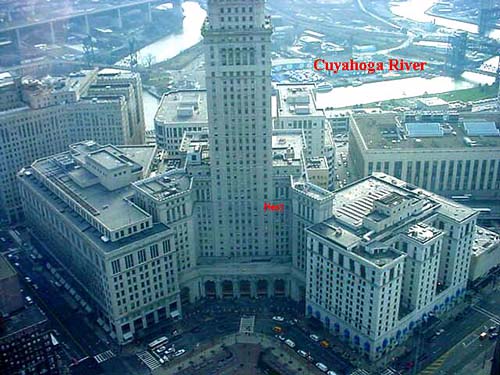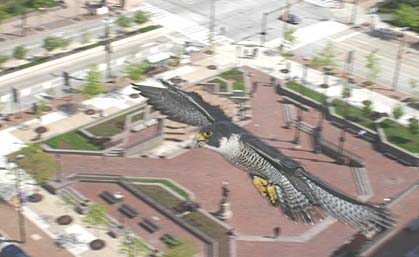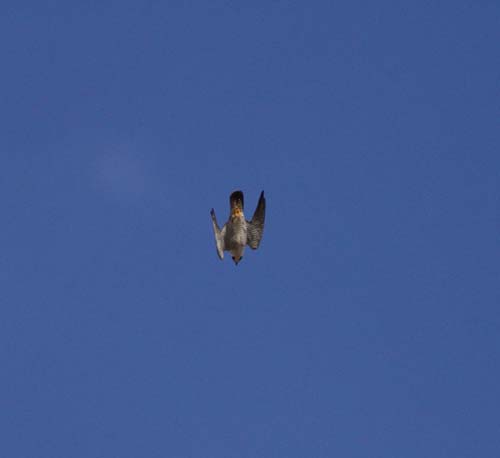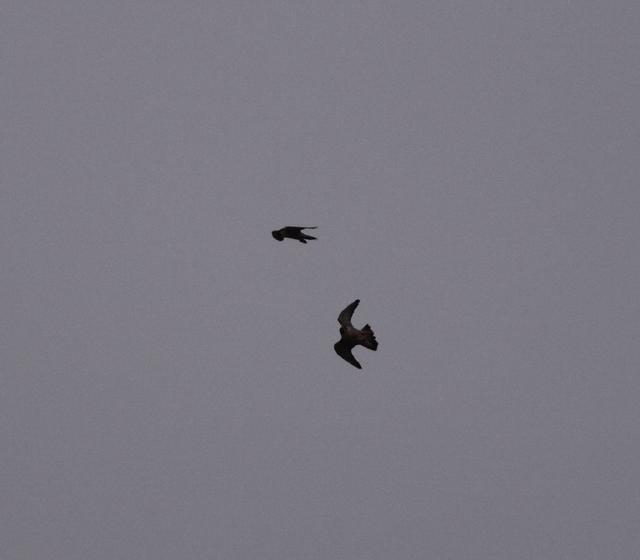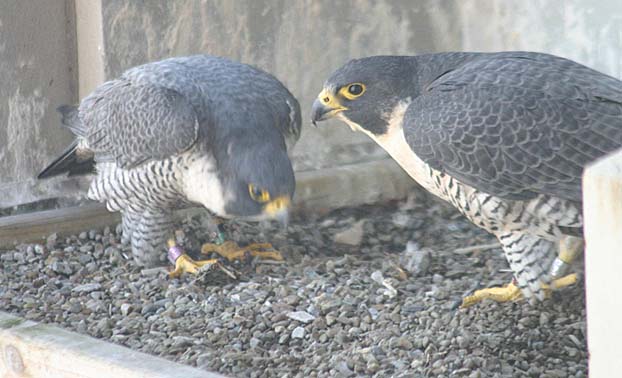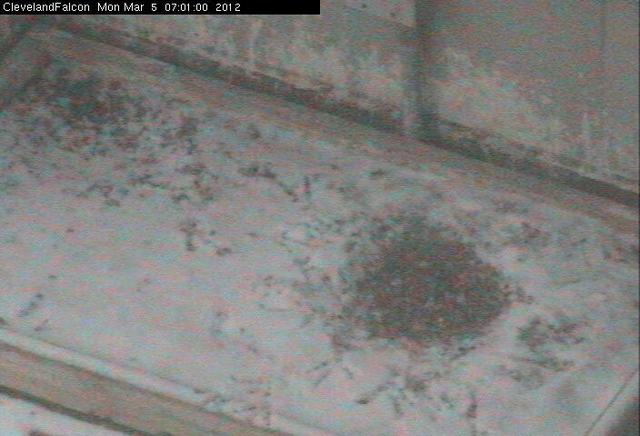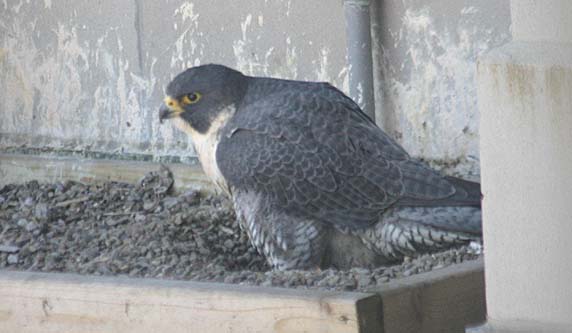FALCON FLASH
Dateline: Cleveland, Ohio
March 4, 2012
The 2012 peregrine falcon nesting season is underway at Boomer and SW's home sweet home located on the 12th floor ledge of a skyscraper called "Tower City" in downtown Cleveland, Ohio
(look for red label showing nestbox location).
This is a picture of SW with Cleveland’s Public Square in the background. The nestbox overlooks Public Square.
Longer daylight hours and warmer days are now triggering the birds into courtship, and SW and Boomer have begun the annual nesting life-cycle. They spend time in the nestbox together as well as flying, hunting, and eating together. Every year the male must prove his worth and court his mate (even if it is the same mate from year to year). “Courtship feeding” where the male catches prey and presents it to the female, proves that the male will be a good provider and also gives the female the extra nutritional boost she needs to lay healthy eggs. Just before she lays her eggs, she becomes too heavy to hunt on her own.
In the following picture Boomer performs a dive-down flight called a “stoop” as he draws his wings in so he is shaped like a bullet. It is in the stoop that peregrines achieve their highest speeds, which can reach 200 miles per hour or more.
Scott Wright, peregrine falcon nest monitor at this site for 20 years, describes courtship flight:
“The male peregrine falcon must showcase his flying ability with stunning displays. Boomer will do a dance in the sky by making long soaring, diving, and gliding displays with tail feathers and wingtip feathers wide open. He will pass close by SW with his tail feathers all displayed and stretched out, and he and SW will vocalize to each other. This will continue for some time, and on warmer days with higher winds, the couple will take to the air and together fly a dance across the sky”.
Click here to read what happened earlier
The photo of the Tower City skyscraper is courtesy of falcon fan Tony Rinicella. Thanks to volunteers Mr. and Mrs. Saladin for the picture of Boomer in the dive. All other photos are courtesy of volunteer nest monitor Scott Wright. Pictures can be used in any non-commercial publication, electronic or print, but please give photo credit.
Stay tuned for falcon news…….
To watch the falcons live go to: http://www.falconcam-cmnh.org/news.php Our thanks to the Cleveland Museum of Natural History for sponsoring the FalconCams and for the still.
For more about falcons go to www.raptorsinthecity.org
Male peregrines are about one-third smaller than females and are called “tiercels”, which comes from an old French word meaning “one-third”. Female peregrines are fierce predators and the larger females can be aggressive toward their mates. Some scientists believe the male approaches his mate cautiously and bows to her to as if to say “please don’t hurt me”, but since the male is a fierce predator also, he may be bowing to show his mate he is not a threat to her.
For more information about falcon courtship, visit the Santa Cruz Predatory Bird Research Group website at: http://www2.ucsc.edu/scpbrg/pefabehavior.htm
Here's a good idea for young scientists from Sara Jean Peters of the Ohio Division of Wildlife (retired): "The FalconCam "hour review" of images provides an interesting way for kids to practice "sampling" techniques used by wildlife researchers. One would assume that, as the pair extends its courtship, the birds would be seen more and more frequently at the nest tray. By counting the number of frames that contain a view of a peregrine and dividing by 60, the students can calculate the percentage of time spent at the site during the sample period. They could choose several sample periods during the day and see if visitation varies by time of day... How does it change when the chicks are 12 days old...."
This is a still taken from the FalconCam. What observations can you make?
To see the "hour review" each day, go to the live FalconCam at:http://www.falconcam-cmnh.org/news.php
Under each of the 3 pictures of the nest on the front page there is a link that will take you to the archives. The live FalconCam takes a picture each minute of every daylight hour. There are 60 pictures for each hour each day. Looking at the archives will give you a quick review of all the day's activities. As you observe the nest every day, why not take Ms. Peterson's suggestion and record how much of the time the falcons are at the nest in one hour and what their activities are? Sampling the nest every day will give you some interesting information about falcon behavior.
There has been a great deal of courting behavior going on at the falcon nestsite. Will there be eggs this year? Mr. Wright was at the nest recently and snapped this picture. Do you think SW could be carrying eggs?
Click here to read what happened next

